American black bear
The American black bear (Ursus americanus, previously known as Euarctos americanus) is a medium-sized bear native to North America. It is the continent's smallest and most widely distributed bear species. American black bears are omnivores, with their diets varying greatly depending on season and location. They typically live in largely forested areas, but do leave forests in search of food. Sometimes they become attracted to human communities because of the immediate availability of food. The American black bear is the world's most common bear species.
| American black bear | |
|---|---|
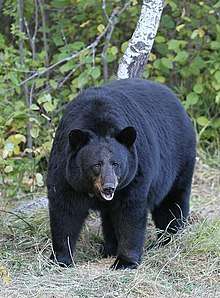 | |
| An American black bear in Manitoba's Riding Mountain National Park | |
| Scientific classification | |
| Kingdom: | Animalia |
| Phylum: | Chordata |
| Class: | Mammalia |
| Order: | Carnivora |
| Family: | Ursidae |
| Genus: | Ursus |
| Species: | U. americanus |
| Binomial name | |
| Ursus americanus Pallas, 1780 | |
| Subspecies | |
|
16, see text | |
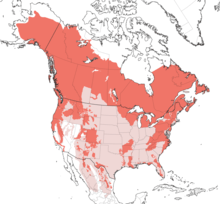 | |
| American black bear range[1]
Present-day range Extirpated | |
| Synonyms | |
|
Euarctos americanus | |
It is listed by the International Union for Conservation of Nature (IUCN) as a least-concern species, due to its widespread distribution and a large population estimated to be twice that of all other bear species combined. Along with the brown bear, it is one of only two of the eight modern bear species not considered by the IUCN to be globally threatened with extinction.
Taxonomy and evolution
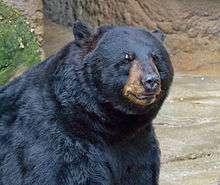
Despite living in North America, American black bears are not closely related to brown bears and polar bears; genetic studies reveal that they split from a common ancestor 5.05 million years ago (mya).[2] American and Asian black bears are considered sister taxa and are more closely related to each other than to the other modern species of bears.[2][3] According to recent studies, the sun bear is also a relatively recent split from this lineage.[4]
A small primitive bear called Ursus abstrusus is the oldest known North American fossil member of the genus Ursus, dated to 4.95 mya.[5] This suggests that U. abstrusus may be the direct ancestor of the American black bear, which evolved in North America.[2][6] Although Wolverton and Lyman still consider U. vitabilis an "apparent precursor to modern black bears",[7] it has also been placed within U. americanus.[6]
The ancestors of American black bears and Asian black bears diverged from sun bears 4.58 mya. The American black bear then split from the Asian black bear 4.08 mya.[2][8] The earliest American black bear fossils, which were located in Port Kennedy, Pennsylvania, greatly resemble the Asian species,[9] though later specimens grew to sizes comparable to grizzly bears.[10] From the Holocene to the present, American black bears seem to have shrunk in size,[2] but this has been disputed because of problems with dating these fossil specimens.[7]
The American black bear lived during the same period as the giant and lesser short-faced bears (Arctodus simus and A. pristinus, respectively) and the Florida spectacled bear (Tremarctos floridanus). These tremarctine bears evolved from bears that had emigrated from Asia to North America 7–8 ma.[11] The giant and lesser short-faced bears are thought to have been heavily carnivorous and the Florida spectacled bear more herbivorous,[12] while the American black bears remained arboreal omnivores, like their Asian ancestors. The American black bear's generalist behavior allowed it to exploit a wider variety of foods and has been given as a reason why, of these three genera, it alone survived climate and vegetative changes through the last Ice Age while the other, more specialized North American predators became extinct. However, both Arctodus and Tremarctos had survived several other, previous ice ages. After these prehistoric ursids became extinct during the last glacial period 10,000 years ago, American black bears were probably the only bear present in much of North America until the migration of brown bears to the rest of the continent.[10]
Hybrids
American black bears are reproductively compatible with several other bear species and have occasionally produced hybrid offspring. According to Jack Hanna's Monkeys on the Interstate, a bear captured in Sanford, Florida, was thought to have been the offspring of an escaped female Asian black bear and a male American black bear.[13] In 1859, an American black bear and a Eurasian brown bear were bred together in the London Zoological Gardens, but the three cubs that were born died before they reached maturity. In The Variation of Animals and Plants under Domestication, Charles Darwin noted:
In the nine-year Report it is stated that the bears had been seen in the zoological gardens to couple freely, but previously to 1848 most had rarely conceived. In the reports published since this date three species have produced young (hybrids in one case), ...[14]
A bear shot in autumn 1986 in Michigan was thought by some to be an American black bear/grizzly bear hybrid, due to its unusually large size and its proportionately larger brain case and skull. DNA testing was unable to determine whether it was a large American black bear or a grizzly bear.[15]
Subspecies
Listed alphabetically according to subspecific name:[16][17]
| Scientific name | Common name | Distribution | Description |
|---|---|---|---|
| Ursus americanus altifrontalis | Olympic black bear | The Pacific Northwest coast from central British Columbia through northern California and inland to the tip of northern Idaho and British Columbia | |
| Ursus americanus amblyceps | New Mexico black bear | Colorado, New Mexico, western Texas and the eastern half of Arizona into northern Mexico and southeastern Utah | |
| Ursus americanus americanus | Eastern black bear | Eastern Montana to the Atlantic coast, from Alaska south and east through Canada to Maine and south to Texas. Thought to be increasing in some regions. | Common to Eastern Canada and the eastern U.S. wherever suitable habitat is found. A large-bodied subspecies; almost all specimens have black fur. May very rarely sport a white blaze on the chest. |
| Ursus americanus californiensis | California black bear | The mountain ranges of southern California, north through the Central Valley to southern Oregon | Able to live in varied climates: found in temperate rain forest in the north and chaparral shrubland in the south. Small numbers may feature cinnamon-colored fur. |
| Ursus americanus carlottae | Haida Gwaii black bear or Queen Charlotte Islands black bear | The Haida Gwaii (a.k.a. the Queen Charlotte Islands) and Alaska | Generally larger than its mainland counterparts with a huge skull and molars and found only in a black color phase.[18] |
| Ursus americanus cinnamomum | Cinnamon bear | Colorado, Idaho, western Montana and Wyoming, eastern Washington and Oregon and northeastern Utah | Has brown or reddish-brown fur, reminiscent of cinnamon. |
| Ursus americanus emmonsii | Glacier bear | Southeastern Alaska. Stable. | Distinguished by its fur being silvery-gray with a blue luster found mostly on its flanks.[19] |
| Ursus americanus eremicus | East Mexican black bear | Northeastern Mexico and U.S. borderlands with Texas. Critically endangered. | Most often found in Big Bend National Park and the desert border with Mexico. Numbers unknown in Mexico, but are presumed to be very low. |
| Ursus americanus floridanus | Florida black bear | Florida, southern Georgia, Alabama and Mississippi (except the southern region) | Has a light brown nose and shiny black fur. A white blaze on the chest is common in this subspecies. An average male weighs 136 kg (300 lb). |
| Ursus americanus hamiltoni | Newfoundland black bear | Newfoundland | Generally bigger than its mainland relatives, ranging in size from 90 to 270 kg (200 to 600 lb) and averaging 135 kg (298 lb). It has one of the longest hibernation periods of any bear in North America.[20] Known to favor foraging in fields of Vaccinium species. |
| Ursus americanus kermodei | Kermode bear or spirit bear | The central coast of British Columbia | Approximately 10% of the population of this subspecies have white or cream-colored coats due to a recessive gene and are called "Kermode bears" or "spirit bears". The other 90% appear as normal-colored black bears.[21] |
| Ursus americanus luteolus | Louisiana black bear | Eastern Texas, Louisiana and southern Mississippi. Listed as Threatened on the U.S. federal endangered species list, but removed from the list on April 11, 2016.
The validity of this subspecies has been repeatedly debated.[1] |
Has relatively long, narrow and flat skull and proportionately large molars.[22] Prefers hardwood bottom forests and bayous as habitat. |
| Ursus americanus machetes | West Mexican black bear | North-central Mexico | |
| Ursus americanus perniger | Kenai black bear | The Kenai Peninsula, Alaska | |
| Ursus americanus pugnax | Dall Island black bear | Dall Island in the Alexander Archipelago, Alaska | |
| Ursus americanus vancouveri | Vancouver Island black bear | Vancouver Island, British Columbia | Found in the northern section of the island, but it occasionally will appear in the suburbs of the Victoria metropolitan area. |
Distribution and population
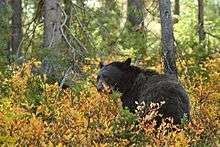
Historically, American black bears occupied the majority of North America's forested regions. Today, they are primarily limited to sparsely settled, forested areas.[23] American black bears currently inhabit much of their original Canadian range, though they seldom occur in the southern farmlands of Alberta, Saskatchewan and Manitoba; they have been extinct on Prince Edward Island since 1937.[24] The total Canadian black bear population is between 396,000 and 476,000,[25] based on surveys taken in the mid-1990s in seven Canadian provinces, though this estimate excludes American black bear populations in New Brunswick, the Northwest Territories, Nova Scotia and Saskatchewan. All provinces indicated stable populations of American black bears over the last decade.[23]
The current range of American black bears in the United States is constant throughout most of the northeast and within the Appalachian Mountains almost continuously from Maine to northern Georgia, the northern Midwest, the Rocky Mountain region, the West Coast and Alaska.[24] However, it becomes increasingly fragmented or absent in other regions. Despite this, American black bears in those areas seem to have expanded their range during the last decade, such as with recent sightings in Ohio[24] and southern Indiana,[26] though these probably do not yet represent stable breeding populations. Sightings of itinerant American black bears in the Driftless Area of southeast Minnesota, northeast Iowa, and southwest Wisconsin are common.[27][28] In the spring of 2019, biologists with the Iowa Department of Natural Resources confirmed documentation of an American black bear living year-round in woodlands near the town of Decorah in northeast Iowa, believed to be the first instance of a resident black bear in Iowa since the 1880s.[29][30]
Surveys taken from 35 states in the early 1990s indicate that American black bears are either stable or increasing, except in Idaho and New Mexico. The overall population of American black bears in the United States has been estimated to range between 339,000 and 465,000,[31] though this excludes populations from Alaska, Idaho, South Dakota, Texas and Wyoming, whose population sizes are unknown.[23] In the state of California, there are an estimated 25,000-35,000 American black bears, making it the largest population of the species in the contiguous United States.[32][33]
As of 1993, known Mexican black bear populations existed in four areas, though knowledge on the distribution of populations outside those areas has not been updated since 1959. Mexico is the only country where the American black bear is classified as "endangered".[23]
There have been several sightings quite far away from where the American black bear is normally found, such as Union County, North Carolina[34][35] and western Nebraska.[36]
Habitat
Throughout their range, habitats preferred by American black bears have a few shared characteristics. They are often found in areas with relatively inaccessible terrain, thick understory vegetation and large quantities of edible material (especially masts). The adaptation to woodlands and thick vegetation in this species may have originally been due to the American black bear having evolved alongside larger, more aggressive bear species, such as the extinct giant short-faced bear and the still-living grizzly bear, that monopolized more open habitats [37] and the historic presence of larger predators, such as Smilodon and the American lion, that could have preyed on American black bears. Although found in the largest numbers in wild, undisturbed areas and rural regions, American black bears can adapt to surviving in some numbers in peri-urban regions, as long as they contain easily accessible foods and some vegetative coverage.[4]
In most of the contiguous United States, American black bears today are usually found in heavily vegetated mountainous areas, from 400 to 3,000 m (1,300 to 9,800 ft) in elevation. For American black bears living in the American Southwest and Mexico, habitat usually consists of stands of chaparral and pinyon juniper woods. In this region, bears occasionally move to more open areas to feed on prickly pear cactus. At least two distinct, prime habitat types are inhabited in the Southeastern United States. American black bears in the southern Appalachian Mountains survive in predominantly oak-hickory and mixed mesophytic forests. In the coastal areas of the Southeast (such as Florida, the Carolinas and Louisiana), bears inhabit a mixture of flatwoods, bays and swampy hardwood sites.
In the northeast part of the range (United States and Canada), prime habitat consists of a forest canopy of hardwoods such as beech, maple, birch and coniferous species. Corn crops and oak-hickory mast are also common sources of food in some sections of the Northeast; small, thick swampy areas provide excellent refuge cover largely in stands of white cedar. Along the Pacific coast, redwood, Sitka spruce and hemlocks predominate as overstory cover. Within these northern forest types are early successional areas important for American black bears, such as fields of brush, wet and dry meadows, high tidelands, riparian areas and a variety of mast-producing hardwood species. The spruce-fir forest dominates much of the range of the American black bear in the Rockies. Important nonforested areas here are wet meadows, riparian areas, avalanche chutes, roadsides, burns, sidehill parks and subalpine ridgetops.
In areas where human development is relatively low, such as stretches of Canada and Alaska, American black bears tend to be found more regularly in lowland regions.[37] In parts of northeastern Canada, especially Labrador, American black bears have adapted exclusively to semi-open areas that are more typical habitat in North America for brown bears (likely due to the absence here of brown and polar bears, as well as other large carnivore species).[4]
Description
Build
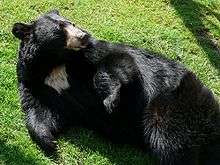
The skulls of American black bears are broad, with narrow muzzles and large jaw hinges. In Virginia, the total length of adult bear skulls was found to average 262 to 317 mm (10.3 to 12.5 in).[37] Across its range, the greatest skull length for the species has been reportedly measured from 23.5 to 35 cm (9.3 to 13.8 in).[4] Females tend to have slenderer and more pointed faces than males. Their claws are typically black or grayish-brown. The claws are short and rounded, being thick at the base and tapering to a point. Claws from both hind and front legs are almost identical in length, though the foreclaws tend to be more sharply curved. The paws of the species are relatively large, with a rear foot length of 13.7 to 22.5 cm (5.4 to 8.9 in), which is proportionately larger than other medium-sized bear species, but much smaller than the paws of large adult brown, and especially polar, bears.[4] The soles of the feet are black or brownish and are naked, leathery and deeply wrinkled. The hind legs are relatively longer than those of Asian black bears. The vestigial tail is usually 4.8 inches (120 mm) long. The ears are small and rounded and are set well back on the head.
American black bears are highly dexterous, being capable of opening screw-top jars and manipulating door latches. They also have great physical strength. They have been known to turn over flat-shaped rocks weighing 310 to 325 pounds (141 to 147 kg) by flipping them over with a single foreleg.[39] They move in a rhythmic, sure-footed way and can run at speeds of 25 to 30 miles per hour (40 to 48 km/h).[40] American black bears have good eyesight and have been proven experimentally to be able to learn visual color discrimination tasks faster than chimpanzees and just as fast as domestic dogs. They are also capable of rapidly learning to distinguish different shapes such as small triangles, circles and squares.[41]
Size
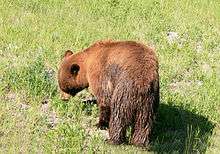
American black bear weight tends to vary according to age, sex, health and season. Seasonal variation in weight is very pronounced: in autumn, their pre-den weight tends to be 30% higher than in spring, when black bears emerge from their dens. American black bears on the East Coast tend to be heavier on average than those on the West Coast, although American black bears follow Bergmann's rule and bears from the Northwest are often slightly heavier than the bears from the Southeast. Adult males typically weigh between 57–250 kg (126–551 lb), while females weigh 33% less at 41–170 kg (90–375 lb).[4][42]
In the state of California, studies have indicated that the average mass is 86 kg (190 lb) in adult males and 58 kg (128 lb) in adult females.[37] Adult American black bears in Yukon Flats National Wildlife Refuge in east-central Alaska were found to average 87.3 kg (192 lb) in males and 63.4 kg (140 lb) in females, whereas on Kuiu Island in southeast Alaska (where nutritious salmon are readily available) adult American black bears averaged an estimated 115 kg (254 lb).[43][44] In Great Smoky Mountains National Park, adult males averaged 112 kg (247 lb) and adult females averaged 47 kg (104 lb) per one study.[45] In one of the largest studies on regional body mass, bears in British Columbia averaged 73.7 kg (162 lb) in 89 females and 103.1 kg (227 lb) in 243 males.[46] In Yellowstone National Park, a population study found that adult males averaged 119 kg (262 lb) and adult females averaged 67 kg (148 lb).[47] Black bears in north-central Minnesota averaged 69.9 kg (154 lb) in 163 females and 124.95 kg (275 lb) in 77 males.[48] In New York, the two sexes reportedly average 135 kg (298 lb) and 74 kg (163 lb), respectively.[49] It was found in Nevada and Lake Tahoe region that black bears closer to urban regions were significantly heavier than their arid-country dwelling counterparts, with males near urban areas averaging 138 kg (304 lb) against wild-land males which averaged 115.5 kg (255 lb) whereas peri-urban females averaged 97.9 kg (216 lb) against the average of 65.2 kg (144 lb) in wild-land ones.[50] In Waterton Lakes National Park, Alberta adults reportedly averaged 125 to 128 kg (276 to 282 lb).[51] Adults typically range from 120 to 200 cm (47 to 79 in) in head-and-body length, and 70 to 105 cm (28 to 41 in) in shoulder height. The typically small tail is 7.7–17.7 cm (3.0–7.0 in) long.[39][52][53][54] Although they are the smallest bear species in North America, large males exceed the size of other bear species, except the brown bear and the polar bear.[39]
The biggest wild American black bear ever recorded was a male from New Brunswick, shot in November 1972, that weighed 409 kg (902 lb) after it had been dressed, meaning it weighed an estimated 500 kg (1,100 lb) in life and measured 2.41 m (7.9 ft) long.[55] Another notably outsized wild American black bear, weighing in at 408 kg (899 lb) in total, was the cattle-killer shot in December 1921 on the Moqui Reservation in Arizona.[55] The record-sized American black bear from New Jersey was shot in Morris County December 2011 and scaled 376.5 kg (830 lb).[56] Even larger, the most massive American black bear recorded in Pennsylvania (one of six weighing over 363 kg (800 lb) shot in the last 15 years in the state) weighed in at 399 kg (880 lb) and was shot in November 2010 in Pike County.[57] The North American Bear Center, located in Ely, Minnesota, is home to the world's largest captive male and female American black bears. Ted, the male, weighed 431–453.5 kg (950–1,000 lb) in the fall of 2006.[58] Honey, the female, weighed 219.6 kg (484 lb) in the fall of 2007.[59]
Pelage
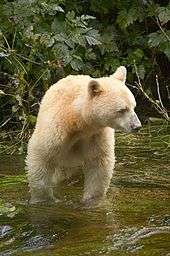
The fur is soft, with dense underfur and long, coarse, thick guard hairs.[39] The fur is not as shaggy or coarse as that of brown bears.[60] American black bear skins can be distinguished from those of Asian black bears by the lack of a white blaze on the chest and hairier footpads.[61] Despite their name, American black bears show a great deal of color variation. Individual coat colors can range from white, blonde, cinnamon, light brown or dark chocolate brown to jet black, with many intermediate variations existing. Silvery-gray American black bears with a blue luster (this is found mostly on the flanks) occur along a portion of coastal Alaska and British Columbia. White to cream-colored American black bears occur in the coastal islands and the adjacent mainland of southwestern British Columbia. Albino specimens have also been recorded.[62] Black coats tend to predominate in moist areas such as Maine, New York, Tennessee, Michigan and western Washington. Approximately 70% of all American black bears are black, though only 50% of American black bears in the Rocky Mountains are black.[39] Many American black bears in northwestern North America are cinnamon, blonde or light brown in color and thus may sometimes be mistaken for grizzly bears. Grizzly (and other types of brown) bears can be distinguished by their shoulder hump, larger size and broader, more concave skull.[63]
In his book The Great Bear Almanac, Gary Brown summarized the predominance of black or brown/blonde specimens by location:[39]
| Color variations of American black bears by location | |
|---|---|
| Location | Color breakdown |
| Michigan | 100% black |
| Minnesota | 94% black, 6% brown |
| New England | 100% black |
| New York | 100% black |
| Tennessee | 100% black |
| Washington (coastal) | 99% black, 1% brown or blonde |
| Washington (inland) | 21% black, 79% brown or blonde |
| Yosemite National Park | 9% black, 91% brown or blonde |
Behavior and life history
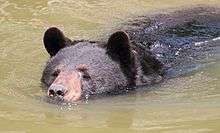
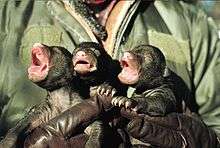
American black bears have better eyesight and hearing than humans. Their keenest sense is their sense of smell, which is about seven times more sensitive than a domestic dog's.[64] American black bears are excellent and strong swimmers, swimming for pleasure and to feed (largely on fish). They regularly climb trees to feed, escape enemies and hibernate. Four of the eight modern bear species are habitually arboreal (the most arboreal species, the American and Asian black bears and the sun bear, being fairly closely related).[4] Their arboreal abilities tend to decline with age.[40] They may be active at any time of the day or night, although they mainly forage by night. American black bears living near human habitations tend to be more extensively nocturnal, while those living near brown bears tend to be more extensively diurnal.[4][37]
American black bears tend to be territorial and non-gregarious in nature. However, at abundant food sources (e.g. spawning salmon or garbage dumps), they may congregate and dominance hierarchies form, with the largest, most powerful males dominating the most fruitful feeding spots.[65] They mark their territories by rubbing their bodies against trees and clawing at the bark. Annual ranges held by mature male American black bears tend to be very large, though there is some variation. On Long Island off the coast of Washington, ranges average 5 sq mi (13 km2), whereas on the Ungava Peninsula in Canada ranges can average up to 1,000 sq mi (2,600 km2), with some male bears traveling as far as 4,349 sq mi (11,260 km2) at times of food shortages.[4][65]
American black bears may communicate with various vocal and non-vocal sounds. Tongue-clicking and grunting are the most common sounds and are made in cordial situations to conspecifics, offspring and occasionally humans. During times of fear or nervousness, bears may moan, huff or blow air. Warning sounds include jaw-clicking and lip-popping. In aggressive interactions, American black bears produce deep-throated pulsing sounds. Cubs may squeal, bawl or scream when in distress and make a motor-like humming sound when comfortable or nursing.[66][67][68] American black bears often mark trees using their teeth and claws as a form of communication with other bears, a behavior common to many species of bears.[1]
Reproduction and development
Sows usually produce their first litter at the age of three to five years,[40] with those living in more developed areas tending to get pregnant at younger ages.[69] The breeding period usually occurs in the June–July period, though it can extend to August in the species' northern range. The breeding period lasts for two to three months. Both sexes are promiscuous. Males try to mate with several females, but large, dominant ones may violently claim a female if another mature male comes near.[37] Sows tend to be short-tempered with their mates after copulating. The fertilized eggs undergo delayed development and do not implant in the female's womb until November. The gestation period lasts 235 days and litters are usually born in late January to early February. Litter size is between one and six cubs, typically two or three.[70] At birth, cubs weigh 280–450 g (0.62–0.99 lb) and measure 20.5 cm (8.1 in) in length. They are born with fine, gray, down-like hair and their hind quarters are underdeveloped. They typically open their eyes after 28–40 days and begin walking after five weeks. Cubs are dependent on their mother's milk for 30 weeks and will reach independence at 16–18 months. At the age of six weeks, they attain 900 g (2.0 lb), by the age of eight weeks they reach 2.5 kg (5.5 lb) and by the age of six months they weigh 18 to 27 kg (40 to 60 lb). They reach sexual maturity at the age of three years and attain their full growth at the age of five years.[40]
Longevity and mortality
The average lifespan in the wild is 18 years, though it is quite possible for wild specimens to survive for more than 23 years.[63] The record age of a wild specimen was 39 years,[71] while that in captivity was 44 years.[39] The average annual survival rate for adult American black bears is variable, ranging from 86% in Florida to 73% in Virginia and North Carolina.[37] In Minnesota, 99% of wintering adult bears were able to survive the hibernation cycle in one study.[37] Remarkably, a study of American black bears in Nevada found that the amount of annual mortality of a population of bears in wilderness areas was 0%, whereas in developed areas in the state this figure rose to 83%.[4] Survival in subadults is generally less assured. In Alaska, only 14–17% of subadult males and 30–48% of subadult females were found in a study to survive to adulthood.[37] Across the range, the estimated number of cubs who survive past their first year is 60%.[4]
With the exception of the rare confrontation with an adult brown bear or a gray wolf pack, adult American black bears are not usually subject to natural predation.[37] However, as evidenced by scats with fur inside of them and the recently discovered carcass of an adult sow with puncture marks in the skull, American black bears may occasionally have fallen, and still do fall, prey to jaguars in the southern parts of their range. In such scenarios, the big cat would have the advantage if it ambushed the bear, killing it with a crushing bite to the back of the skull.[72] American black bear cubs tend to be more vulnerable to predation than adults. Known predators of bear cubs have included bobcats, coyotes, cougars, gray wolves, brown bears and other bears of their own species.[4][37] Many of these will stealthily snatch small cubs right from under the sleeping mother. There is a single record of a golden eagle snatching a yearling cub.[4] Once out of hibernation, mother bears may be able to fight off most potential predators.[37] Even cougars will be displaced by an angry mother bear if they are discovered stalking the cubs.[73] Flooding of dens after birth may also occasionally kill newborn cubs. However, in current times, American black bear fatalities are overwhelmingly attributable to human activities. Seasonally, tens of thousands of American black bears are hunted legally across North America, with many more being illegally poached or trapped. Auto collisions also may claim many American black bear lives annually.[4][37]
Hibernation
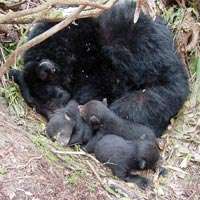
American black bears were once not considered true or "deep" hibernators, but because of discoveries about the metabolic changes that allow American black bears to remain dormant for months without eating, drinking, urinating or defecating, most biologists have redefined mammalian hibernation as "specialized, seasonal reduction in metabolism concurrent with scarce food and cold weather". American black bears are now considered highly efficient hibernators.[74][75] The physiology of American black bears in the wild is closely related to that of bears in captivity. Understanding the physiology of bears in the wild is vital to the bear's success in captivity.[76]
The bears enter their dens in October and November, although in the southernmost areas of their range (i.e. Florida, Mexico, the Southeastern United States), only pregnant females and mothers with yearling cubs will enter hibernation.[4] Prior to that time, they can put on up to 14 kg (30 lb) of body fat to get them through the several months during which they fast. Hibernation in American black bears typically lasts 3–8 months, depending on regional climate.[18][77]
Hibernating American black bears spend their time in hollowed-out dens in tree cavities, under logs or rocks, in banks, caves, or culverts and in shallow depressions. Although naturally-made dens are occasionally used, most dens are dug out by the bear itself.[63] Females have been shown to be pickier in their choice of dens in comparison to males.[78]
During their time in hibernation, an American black bear's heart rate drops from 40–50 beats per minute to 8 beats per minute and the metabolic rate can drop to a quarter of the bear's (non-hibernating) basal metabolic rate (BMR). These reductions in metabolic rate and heart rate do not appear to decrease the bear's ability to heal injuries during hibernation.[79]
The hibernating American black bear does not display the same rate of muscle and bone atrophy relative to other nonhibernatory animals that are subject to long periods of inactivity due to ailment or old age.[80][81] A hibernating American black bear loses approximately half the muscular strength compared to that of a well-nourished, inactive human. The bear's bone mass does not change in geometry or mineral composition during hibernation, which implies that the bear's conservation of bone mass during hibernation is due to a biological mechanism.[82] During hibernation American black bears retain all excretory waste, leading to the development of a hardened mass of fecal material in the colon known as a fecal plug.[83] A special hormone, leptin, is released into the bear's systems to suppress appetite. The retention of waste during hibernation (specifically in minerals such as calcium) may play a role in the bear's resistance to atrophy.[80]
The body temperature of the American black bear does not drop significantly, like other mammalian hibernators (staying around 35 °C (95 °F)) and they remain somewhat alert and active. If the winter is mild enough, they may wake up and forage for food. Females also give birth in February and nurture their cubs until the snow melts.[84] During winter, American black bears consume 25–40% of their body weight.[85] The footpads peel off while they sleep, making room for new tissue.
Many of the physiological changes an American black bear exhibits during hibernation are retained slightly post-hibernation. Upon exiting hibernation, bears retain a reduced heart rate and basal metabolic rate. The metabolic rate of a hibernating bear will remain at a reduced level for up to 21 days after hibernation.[86] After emerging from their winter dens in spring, they wander their home ranges for two weeks so that their metabolism accustoms itself to the activity. In mountainous areas, they seek southerly slopes at lower elevations for forage and move to northerly and easterly slopes at higher elevations as summer progresses.
Dietary habits
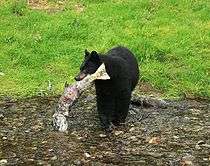
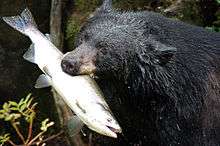
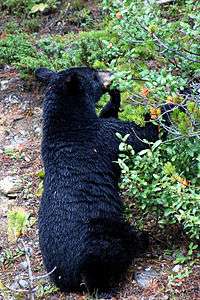
Generally, American black bears are largely crepuscular in foraging activity, though they may actively feed at any time.[65] Up to 85% of the American black bear's diet consists of vegetation,[40] though they tend to dig less than brown bears, eating far fewer roots, bulbs, corms and tubers than the latter species.[62] When initially emerging from hibernation, they will seek to feed on carrion from winter-killed animals and newborn ungulates. As the spring temperature warms, American black bears seek new shoots of many plant species, especially new grasses, wetland plants and forbs.[85] Young shoots and buds from trees and shrubs during the spring period are also especially important to American black bears emerging from hibernation, as they assist in rebuilding muscle and strengthening the skeleton and are often the only digestible foods available at that time.[87] During summer, the diet largely comprises fruits, especially berries and soft masts such as buds and drupes. During the autumn hyperphagia, feeding becomes virtually the full-time task of American black bears. Hard masts become the most important part of the American black bear's diet in autumn and may even partially dictate the species' distribution. Favored masts such as hazelnuts, oak acorns and whitebark pine nuts may be consumed by the hundreds each day by a single American black bear during the fall.[4][37] During the fall period, American black bears may also habitually raid the nut caches of tree squirrels.[85] Also extremely important in fall are berries such as huckleberries and buffalo berries.[4] American black bears living in areas near human settlements or around a considerable influx of recreational human activity often come to rely on foods inadvertently provided by humans, especially during summertime. These include refuse, birdseed, agricultural products and honey from apiaries.[63]
The majority of the American black bear's animal diet consists of insects, such as bees, yellow jackets, ants and their larvae.[85] American black bears are also fond of honey[88] and will gnaw through trees if hives are too deeply set into the trunks for them to reach it with their paws. Once the hive is breached, the bears will scrape the honeycombs together with their paws and eat them, regardless of stings from the bees.[55] American black bears that live in northern coastal regions (especially the Pacific Coast) will fish for salmon during the night, as their black fur is easily spotted by salmon in the daytime. However, the white-furred Kermode bears of the islands of western Canada have a 30% greater success rate in catching salmon than their black-furred counterparts.[89] Other fish, including suckers, trout and catfish, are readily caught whenever possible.[90] Although American black bears do not often engage in active predation of other large animals for much of the year, the species will regularly prey on mule and white-tailed deer fawns in spring, given the opportunity.[91][92][93] Bears may catch the scent of hiding fawns when foraging for something else and then sniff them out and pounce on them. As the fawns reach 10 days of age, they can outmaneuver the bears and their scent is soon ignored until the next year.[94] American black bears have also been recorded similarly preying on elk calves in Idaho[95] and moose calves in Alaska.[96]
Predation on adult deer is rare, but it has been recorded.[97][98][99] They may even hunt prey up to the size of adult female moose, which are considerably larger than themselves, by ambushing them.[100] There is at least one record of a male American black bear killing two bull elk over the course of six days by chasing them into deep snow banks, which impeded their movements. In Labrador, American black bears are exceptionally carnivorous, living largely off caribou, usually young, injured, sickly or dead specimens, and rodents such as voles. This is believed to be due to a paucity of edible plant life in this sub-Arctic region and a local lack of competing large carnivores (including other bear species).[63] Like brown bears, American black bears try to use surprise to ambush their prey and target the weak, injured, sickly or dying animals in the herds. Once a deer fawn is captured, it is frequently torn apart alive while feeding.[92] If it is able to capture a mother deer in spring, the bear frequently begins feeding on the udder of lactating females, but generally prefers meat from the viscera. American black bears often drag their prey to cover, preferring to feed in seclusion. The skin of large prey is stripped back and turned inside out, with the skeleton usually left largely intact. Unlike gray wolves and coyotes, American black bears rarely scatter the remains of their kills. Vegetation around the carcass is usually matted down by American black bears and their droppings are frequently found nearby. American black bears may attempt to cover remains of larger carcasses, though they do not do so with the same frequency as cougars and grizzly bears.[101] They will readily consume eggs and nestlings of various birds and can easily access many tree nests, even the huge nests of bald eagles.[40] American black bears have been reported stealing deer and other animals from human hunters.
Interspecific predatory relationships
Over much of their range, American black bears are assured scavengers that can intimidate, using their large size and considerable strength, and if necessary dominate other predators in confrontations over carcasses. However, on occasions where they encounter Kodiak or grizzly bears, the larger two brown subspecies dominate them. American black bears tend to escape competition from brown bears by being more active in the daytime and living in more densely forested areas. Violent interactions, resulting in the deaths of American black bears, have been recorded in Yellowstone National Park.[102][103]
American black bears do compete with cougars over carcasses. Like brown bears, they will sometimes steal kills from cougars. One study found that both bear species visited 24% of cougar kills in Yellowstone and Glacier National Parks, usurping 10% of the carcasses.[104][105] Another study found that American black bears visited 48% of cougar kills in summer in Colorado and 77% of kills in California. As a result, the cats spend more time killing and less time feeding on each kill.[106][107]
American black bear interactions with gray wolves are much rarer than with brown bears, due to differences in habitat preferences. The majority of American black bear encounters with wolves occur in the species' northern range, with no interactions being recorded in Mexico. Despite the American black bear being more powerful on a one-to-one basis, packs of wolves have been recorded to kill black bears on numerous occasions without eating them. Unlike brown bears, American black bears frequently lose against wolves in disputes over kills.[108] Wolf packs typically kill American black bears when the larger animals are in their hibernation cycle.[42]
There is at least one record of an American black bear killing a wolverine in a dispute over food in Yellowstone National Park.[109] Anecdotal cases of alligator predation on American black bears have been reported, though such cases may involve assaults on cubs.[110]
Relationships with humans
In folklore, mythology and culture

American black bears feature prominently in the stories of some of America's indigenous peoples. One tale tells of how the black bear was a creation of the Great Spirit, while the grizzly bear was created by the Evil Spirit.[111] In the mythology of the Haida, Tlingit and Tsimshian people of the Northwest Coast, mankind first learned to respect bears when a girl married the son of a black bear chieftain.[112] In Kwakiutl mythology, American black and brown bears became enemies when Grizzly Bear Woman killed Black Bear Woman for being lazy. Black Bear Woman's children, in turn, killed Grizzly Bear Woman's children.[113] The Navajo believed that the Big Black Bear was chief among the bears of the four directions surrounding Sun's house and would pray to it in order to be granted its protection during raids.[114]
Morris Michtom, the creator of the teddy bear, was inspired to make the toy when he came across a cartoon of Theodore Roosevelt refusing to shoot an American black bear cub tied to a tree.[115] The fictional character Winnie-the-Pooh was named after Winnipeg, a female American black bear cub that lived at the London Zoo from 1915 until her death in 1934.[116] An American black bear cub, who in the spring of 1950 was caught in the Capitan Gap Fire, was made into the living representative of Smokey Bear, the mascot of the United States Forest Service.[117]
Terrible Ted was a de-toothed and de-clawed American black bear who was trained to perform as a pro wrestler and whose "career" lasted from the 1950s to the 1970s. The American black bear is the mascot of the University of Maine and Baylor University, where the university houses two live American black bears on campus. Sleeping Bear Dunes in Michigan is named after a Native American legend, where a female bear and her cub swam across Lake Michigan. Exhausted from their journey, the bears rested on the shoreline and fell sound asleep. Over the years, the sand covered them up, creating a huge sand dune.
Attacks on humans
Although an adult bear is quite capable of killing a human, American black bears typically avoid confronting humans whenever possible. Unlike grizzly bears, which became a subject of fearsome legend among the European settlers of North America, American black bears were rarely considered overly dangerous, even though they lived in areas where the pioneers had settled. American black bears rarely attack when confronted by humans and usually limit themselves to making mock charges, emitting blowing noises and swatting the ground with their forepaws. The number of American black bear attacks on humans is higher than those of the brown bear in North America, though this is largely because the American black bear considerably outnumbers the brown bear, rather than greater aggressiveness. Compared to brown bear attacks, aggressive encounters with American black bears rarely lead to serious injury. However, the majority of American black bear attacks tend to be motivated by hunger rather than territoriality and thus victims have a higher probability of surviving by fighting back rather than submitting. Unlike female brown bears, female American black bears do not display the same level of protectiveness toward their cubs and seldom attack humans when they are in the cubs' vicinity.[62] However, occasionally, attacks by protective mothers do occur.[37] The worst recorded fatality incident occurred in May 1978, in which an American black bear killed three teenagers who were fishing in Algonquin Park in Canada.[118] Another exceptional, spree-like attack occurred in August 1997 in Liard River Hot Springs Provincial Park in Canada, when an emaciated American black bear attacked a child and mother, killing the mother as well as an adult man who tried to intervene. This bear was shot while mauling a fourth victim.[119][120]
The majority of attacks happened in national parks, usually near campgrounds, where the bears had become habituated to close human proximity and food-conditioned.[62] Out of 1,028 incidents of American black bears acting aggressively toward people, recorded from 1964 to 1976 in the Great Smoky Mountains National Park, 107 resulted in injury and occurred mainly in tourist hot spots where people regularly fed the bears handouts.[118] In almost every case where open garbage dumps that had previously attracted American black bears were closed and/or handouts had ceased, the number of aggressive encounters with American black bears has decreased precipitously over time.[37] However, in the aforementioned case of the spree attack in Liard River Hot Springs, the attacking bear was believed to have been previously almost fully dependent on a local garbage dump that had closed and was starving to death as a result of the loss of that food source.[119] Attempts to relocate American black bears are typically unsuccessful, as they seem to be able to return to their home range, even without familiar landscape cues.[37]
Livestock and crop predation
A limitation of food sources in early spring and wild berry and nut crop failures during the summer months may be contributing factors to American black bears regularly feeding from commercial human-based food sources. Crops are frequently eaten by these bears, especially during autumn hyperphagia when natural foods are scarce. Favored crops may include apples, oats and corns.[4] American black bears can do extensive damage in some areas of the northwestern United States by stripping the bark from trees and feeding on the cambium. Livestock depredations by American black bears occur mostly in spring. Although American black bears have the capacity to (and occasionally do) hunt adult cattle and horses, they seem to prefer smaller, more easily overwhelmed prey such as sheep, goats, pigs and young calves. They normally kill by biting the neck and shoulders, though they may break the neck or back of the prey with blows from the paws. Evidence of a bear attack includes claw marks and is frequently found on the neck, back and shoulders of larger animals. Surplus killing of sheep and goats are common. American black bears have been known to frighten livestock herds over cliffs, causing injuries and death to many animals; whether or not this is intentional is not known.[101] Occasionally pets, especially domestic dogs, which are most prone to harass a bear, are killed by American black bears.[121] It is not recommended to use unleashed dogs as a deterrent from bear attacks. Although large, aggressive dogs can sometimes cause a bear to run, if pressed, angry bears can frequently turn the tables and end up chasing the dogs in return. A bear in pursuit of a pet dog has the potential to threaten both canid and human lives.[122][123]
In British Columbia, a group of American black bears were used as guard animals to protect a marijuana plantation.[124][125][126]
Hunting and exploitation
Hunting
Historically, American black bears were hunted by both Native Americans and European settlers. Some Native American tribes, in admiration for the American black bear's intelligence, would decorate the heads of bears they killed with trinkets and place them on blankets. Tobacco smoke would be wafted into the disembodied head's nostrils by the hunter that dealt the killing blow, who would compliment the animal for its courage.[55] The Kutchin typically hunted American black bears during their hibernation cycle. Unlike the hunting of hibernating grizzly bears, which was fraught with danger, hibernating American black bears took longer to awaken and hunting them was thus safer and easier.[127] During the European colonisation of eastern North America, thousands of American black bears were hunted for their meat, fat and fur.[3] Theodore Roosevelt wrote extensively on American black bear hunting in his Hunting the Grisly and other sketches, in which he stated,
in [a black bear] chase there is much excitement, and occasionally a slight spice of danger, just enough to render it attractive; so it has always been eagerly followed.
He wrote that American black bears were difficult to hunt by stalking, due to their habitat preferences, though they were easy to trap. Roosevelt described how, in the southern states, planters regularly hunted American black bears on horseback with hounds. General Wade Hampton was known to have been present at 500 successful American black bear hunts, two-thirds of which he killed personally. He killed 30 or 40 American black bears with only a knife, which he would use to stab the bears between the shoulder blades while they were distracted by his hounds.[100] Unless well trained, horses were often useless in American black bear hunts, as they often bolted when the bears stood their ground.[55] In 1799, 192,000 American black bear skins were exported from Quebec. In 1822, 3,000 skins were exported from the Hudson's Bay Company.[128] In 1992, untanned, fleshed and salted American black bear hides were sold for an average of $165.[129]
In Canada, American black bears are considered as both a big game and furbearer species in all provinces, save for New Brunswick and the Northwest Territories, where they are only classed as a big game species. There are around 80,900 licensed American black bear hunters in all of Canada. Canadian black bear hunts take place in the fall and spring and both male and female bears can be legally taken, though some provinces prohibit the hunting of females with cubs, or yearling specimens.[23]
Currently, 28 of the U.S. states have American black bear hunting seasons. 19 states require a bear hunting license, with some also requiring a big game license. In eight states, only a big game license is required to hunt American black bears. Overall, over 481,500 American black bear hunting licences are sold per year. The hunting methods and seasons vary greatly according to state, with some bear hunting seasons including fall only, spring and fall, or year-round. New Jersey, in November 2010, approved a six-day bear-hunting season in early December 2010 to slow the growth of the American black bear population. Bear hunting had been banned in New Jersey for five years before that time.[130] A Fairleigh Dickinson University PublicMind poll found that 53% of New Jersey voters approved of the new season if scientists concluded that American black bears were leaving their usual habitats and destroying private property.[131] Men, older voters and those living in rural areas were more likely to approve of a bear-hunting season in New Jersey than women, younger voters and those living in more developed parts of the state.[131] In the western states, where there are large American black bear populations, there are spring and year-round seasons. Approximately 18,000 American black bears were killed annually in the U.S. between 1988 and 1992. Within this period, annual kills ranged from six bears in South Carolina to 2,232 in Maine.[23]
| Nutritional value per 100 g (3.5 oz) | |
|---|---|
| Energy | 649 kJ (155 kcal) |
0.00 g | |
8.30 g | |
20.10 g | |
| Vitamins | Quantity %DV† |
| Vitamin A equiv. | 10% 78 μg |
| Thiamine (B1) | 14% 0.160 mg |
| Riboflavin (B2) | 57% 0.680 mg |
| Niacin (B3) | 21% 3.200 mg |
| Minerals | Quantity %DV† |
| Iron | 55% 7.20 mg |
| Phosphorus | 23% 162 mg |
| Other constituents | Quantity |
| Water | 71.20 g |
| |
| †Percentages are roughly approximated using US recommendations for adults. Source: USDA Nutrient Database | |
According to Dwight Schuh in his Bowhunter's Encyclopedia, American black bears are the third most popular quarry of bowhunters, behind deer and elk.[132]
Meat
American black bear meat had historically been held in high esteem among North America's indigenous people and colonists.[55] American black bears were the only bear species the Kutchin hunted for their meat, though this constituted only a small part of their diet.[127] According to the second volume of Frank Forester's Field Sports of the United States, and British Provinces, of North America:
The flesh of the [black] bear is savoury, but rather luscious, and tastes not unlike pork. It was once so common an article of food in New-York as to have given the name of Bear Market to one of the principal markets of the city.
— Frank Forester's Field Sports of the United States, and British Provinces, of North America p. 186
Theodore Roosevelt himself likened the flesh of young American black bears to that of pork and not as coarse or flavourless as the meat of grizzly bears.[133] The most favoured cuts of the American black bear's meat are concentrated in the legs and loins. Meat from the neck, front legs and shoulders is usually ground into minced meat, or used for stews and casseroles. Keeping the fat on tends to give the meat a strong flavour. As American black bears can have trichinellosis, cooking temperatures need to be high in order to kill the parasites.[134]
American black bear fat was once valued as a cosmetic article that promoted hair growth and gloss. The fat most favoured for this purpose was the hard white fat found in the body's interior. As only a small portion of this fat could be harvested for this purpose, the oil was often mixed with large quantities of hog lard.[55] However, animal rights activism over the last decade has slowed the harvest of these animals; therefore the lard from American black bears has not been used in recent years for the purpose of cosmetics.
See also
- List of fatal bear attacks in North America
References
- Garshelis, D.L.; Crider, D. & van Manen, F. (2008). "Ursus americanus". IUCN Red List of Threatened Species. 2008. Retrieved January 27, 2009.CS1 maint: ref=harv (link)
- Krause, J.; Unger, T.; Noçon, A.; Malaspinas, A.; Kolokotronis, S.; Stiller, M.; Soibelzon, L.; Spriggs, H.; Dear, P. H.; Briggs, A. W.; Bray, S. C. E.; O'Brien, S. J.; Rabeder, G.; Matheus, P.; Cooper, A.; Slatkin, M.; Pääbo, S.; Hofreiter, M. (2008). "Mitochondrial genomes reveal an explosive radiation of extinct and extant bears near the Miocene-Pliocene boundary". BMC Evolutionary Biology. 8 (#220): 220. doi:10.1186/1471-2148-8-220. PMC 2518930. PMID 18662376.
- Craighead, Lance (2003) Bears of the World, Voyageur Press, ISBN 0-89658-008-3
- Hunter, Luke (2011) Carnivores of the World, Princeton University Press, ISBN 978-0-691-15228-8
- Woodburne, Michael O. (2004). Late Cretaceous and Cenozoic Mammals of North America: Biostratigraphy and Geochronology. Columbia University Press. pp. 178, 252. ISBN 978-0-231-13040-0.
- Kurten, B., and E. Anderson (1980). Pleistocene mammals of North America. Columbia University Press, New York, ISBN 0-231-51696-7.
- Wolverton, S.; Lyman, R. L. (1998). "Measuring late Quaternary Ursid diminution in the Midwest". Quaternary Research. 49 (#3): 322–329. Bibcode:1998QuRes..49..322W. doi:10.1006/qres.1998.1964.
- Lisette Waits, David Paetkau, and Curtis Strobeck, "Overview" from Genetics of the Bears of the World. Chapter 3 of Bears: Status Survey and Conservation Action Plan, compiled by Christopher Servheen, Stephen Herrero and Bernard Peyton, IUCN/SSC Bear Specialist Group
- Herrero, Stephen. "Aspects of Evolution and Adaptation in American Black Bears (Ursus americanus Pallas) and Brown and Grizzly Bears (U. arctos Linne.) of North America" (PDF). Environmental Sciences Centre (Kananaskis). Retrieved February 21, 2011.
- "The American Black Bear". Grizzlybear.org. Archived from the original on March 15, 2010. Retrieved February 21, 2011.
- Qiu, Z. (2003). "Dispersals of Neogene Carnivorans between Asia and North America". Bulletin of the American Museum of Natural History. 279: 18–31. doi:10.1206/0003-0090(2003)279<0018:C>2.0.CO;2.
- Schubert, B. W.; Hulbert, Jr.; MacFadden, B. J.; Searle, M.; Searle, S. (2010). "Giant short-faced bears (Arctodus simus) in Pleistocene Florida USA, a substantial range expansion". Journal of Paleontology. 84: 79–87. doi:10.1666/09-113.1.
- Hybrid Bears. messybeast.com
- Darwin, Charles (1868). The Variation of Animals and Plants under Domestication. 2 (1st ed.). London: John Murray. p. 151. ISBN 978-1-4068-4250-0.
- Smith, Richard P. (2007). "Hybrid Black Bear". Black Bear Hunting. Stackpole Books. ISBN 978-0-8117-0269-0.
- Black Bear Subspecies Archived September 27, 2010, at the Wayback Machine, CoveBear
- Ursus americanus Archived July 19, 2011, at the Wayback Machine, Mammal Species of the World, 3rd ed.
- "Haida Gwaii Black Bear (Ursus Americanus Carlottae Subspecies)" (PDF). Retrieved February 21, 2011.
- "SPECIES VARIATION – Editorial Comment". Wildlife1.wildlifeinformation.org. Archived from the original on July 23, 2011. Retrieved February 21, 2011.
- Black Bear Archived August 21, 2014, at the Wayback Machine, Parks Canada
- "Spirit Bear Facts". Province of British Columbia. Archived from the original on December 17, 2009. Retrieved December 3, 2009.
- . ''Louisiana Black Bear''. (PDF). Retrieved September 15, 2011.
- Pelton, Michael R.; Coley, Alex B.; Eason, Thomas H.; Doan Martinez; Diana L.; Pederson, Joel A.; van Manen, Frank T.; Weaver, Keith M. "Chapter 8. American Black Bear Conservation Action Plan" (PDF). Archived from the original (PDF) on July 23, 2011. Retrieved February 21, 2011.
- Scheick, B. K.; W. McCown (2014). "Geographic distribution of American black bears in North America". Ursus. 25 (#1): 24–33. doi:10.2192/URSUS-D-12-00020.1.
- "Canadian Population". World Wildlife Fund. Retrieved August 31, 2011.
- "Black Bear hit by car in Southern Indiana". Giant FM. November 19, 2018. Retrieved November 19, 2018.
- "Early black bear sightings in southern Wisconsin". Wisconsin Outdoorsman. Retrieved April 24, 2019.
- "Occasional wildlife visitors to Iowa". Iowa Department of Natural Resources. Retrieved April 24, 2019.
- "Biologists excited after black bear caught on camera in northeast Iowa". KCRG Cedar Rapids, Iowa. Retrieved April 24, 2019.
- "Video Shows Bear in Iowa, DNR Says it Could be State's First 'Resident' Bear Since the 1880s". WHO-TV Des Moines, Iowa. Retrieved August 16, 2019.
- "United States Population". World Wildlife Fund. Retrieved August 31, 2011.
- "Archived copy". Archived from the original on August 9, 2017. Retrieved December 2, 2018.CS1 maint: archived copy as title (link)
- "Black Bear Population Information".
- Another black bear sighting in Union Co. Archived July 29, 2013, at the Wayback Machine wsoctv.com. June 25, 2013
- Black bears make a comeback in NC Archived December 21, 2014, at the Wayback Machine. Associated Press. August 3, 2014
- Hoffman, J.; S. Wilson & H. Genoways (2009). "Recent occurrence of an American black bear in Nebraska". Ursus. 20 (#1): 69–72. doi:10.2192/08SC030R.1.
- Lariviere, S. (2001). "Ursus americanus". Mammalian Species. 647: 1–11. doi:10.1644/1545-1410(2001)647<0001:UA>2.0.CO;2.
- "Bears of the World". Americanbear.org. Archived from the original on April 5, 2011. Retrieved February 21, 2011.
- Brown 1993, Ch. "Bear Anatomy and Physiology".
- Brown 1993, Ch. "Behaviour and Activities".
- "Learning and Color Discrimination in the American Black Bear" (PDF). bearbiology.com.
- Scorzafava, Dick (2007). Radical Bear Hunter. Stackpole Books. ISBN 978-0-8117-3418-9.
- Bertram, M.R.; Vivion M. T. (2002). "Black bear monitoring in eastern interior Alaska" (PDF). Ursus. 13 (#69–77). Archived from the original (PDF) on November 8, 2004.
- Peacock, Elizabeth (2004). "Population, Genetic and Behavioral Studies of Black Bears Ursus americanus in Southeast Alaska". PhD Thesis, University of Nevada, Reno
- "Ursus americanus (Pallas); Black Bear". Discoverlife.org. Retrieved December 20, 2012.
- McLellan, B. N. (2011). Implications of a high-energy and low-protein diet on the body composition, fitness, and competitive abilities of black (Ursus americanus) and grizzly (Ursus arctos) bears. Canadian Journal of Zoology, 89(#6), 546-558.
- Barnes, V.G. and Bray, O.E. (1967) "Population characteristics and activities of black bears in Yellowstone National Park". Final report, Colorado Wildl. Res. Unit, Colorado State Univ., Fort Collins; cited in "Characteristics of Black Bears and Grizzly Bears in YNP". nps.gov
- Noyce, K. V., & Garshelis, D. L. (1998). Spring weight changes in black bears in northcentral Minnesota: the negative foraging period revisited. Ursus, 521-531.
- BLACK BEARS IN NEW YORK: Natural History, Range, and Interactions with People. Bureau of Wildlife – Black Bear Management Team, 2003; Second Edition: 2007
- Beckmann, J. P., & Berger, J. (2003). Using black bears to test ideal-free distribution models experimentally. Journal of Mammalogy, 84(#2), 594-606.
- Silva, M., & Downing, J. A. (1995). CRC handbook of mammalian body masses. CRC press.
- Audubon Field Guide. Audubonguides.com. Retrieved September 15, 2011.
- Kronk, C. (2007). Ursus americanus. Animal Diversity Web. Retrieved September 15, 2011.
- "American black bear videos, photos and facts – Ursus americanus" Archived April 23, 2011, at the Wayback Machine. ARKive. Retrieved September 15, 2011.
- Wood, Gerald (1983). The Guinness Book of Animal Facts & Feats. Sterling Publishing Co. ISBN 978-0-85112-235-9.
- Stabile, Jim (December 16, 2011) "829-pound bear takes record in N.J. hunt". Daily Record
- Record-busting, 879-pound bear bagged in Poconos. PoconoRecord.com (November 19, 2010). Retrieved 2013-08-19.
- Rogers, Lyn. "Meet Our Bears > Ted's Page". North American Bear Center. Archived from the original on February 17, 2011. Retrieved February 11, 2011.
- "Meet Our Bears > Honey's Page". North American Bear Center. Archived from the original on February 17, 2011. Retrieved February 11, 2011.
- Wood, John George (1865) The Illustrated Natural History, Vol. 2, George Routledge and Sons
- Ursus thibetanus (G. Cuvier, 1823)
- Herrero, Stephen (2002). Bear Attacks: Their Causes and Avoidance. Globe Pequot. ISBN 978-1-58574-557-9. Retrieved May 16, 2012.
- Macdonald, D.W. (2006) The Encyclopedia of Mammals. Oxford University Press, Oxford ISBN 0-19-956799-9.
- "Black Bear Biology & Behavior". Retrieved November 21, 2013.
- Nowak, R.M. (1991) Walker's Mammals of the World. The Johns Hopkins University Press, Baltimore and London.
- "Vocalizations & Body Language". North American Bear Center. Archived from the original on December 23, 2016. Retrieved December 22, 2016.
- Masterson, Linda (2016). Living With Bears Handbook: Expanded 2nd Edition. PixyJack Press. pp. 215–16. ISBN 978-1936555611.
- Naughton, Donna (2014). The Natural History of Canadian Mammals: Opossums and Carnivores. University of Toronto Press. ISBN 9781442622319.
- "Urban Black Bears "Live Fast, Die Young"". Sciencedaily.com. October 1, 2008. Retrieved February 21, 2011.
- "Reproduction". North American Bear Center. Archived from the original on December 17, 2010.
- "World's oldest-known wild black bear dies at 39" (Press release). Minnesota Department of Natural Resources. August 27, 2013. Archived from the original on March 4, 2016. Retrieved January 4, 2016.
- Grant, Richard (October 2016). "The Return of the Great American Jaguar". Smithsonian Magazine.
- Man Says Bear Saved Him from Mountain Lion Attack in Butte County " CBS Sacramento. Sacramento.cbslocal.com (March 29, 2012). Retrieved 2012-12-21.
- "Hibernation". Bear.org. July 19, 2004. Archived from the original on June 8, 2010. Retrieved February 19, 2011.
- "Yellowstone National Park – Denning and Hibernation Behavior". U.S. National Park Service. April 15, 2008. Retrieved February 19, 2011.
- McCain, Stephanie; Ramsay, Ed; Kirk, Claudia (June 1, 2013). "The effects of hibernation and captivity on glucose metabolism and thyroid hormones in American black bear (Ursus americanus)". Journal of Zoo and Wildlife Medicine. 44 (#2): 324–332. doi:10.1638/2012-0146R1.1. ISSN 1042-7260. PMID 23805551.
- Michigan, Department of Natural Resources (November 19, 2004). "Michigan Black Bear Facts". State of Michigan. Retrieved April 5, 2015.
- Goals, Ben. "American Black Bear Teaching Guide" (PDF). Cornell. Archived from the original (PDF) on April 2, 2012. Retrieved November 22, 2009.
- Iaizzo, Paul A.; Laske, Timothy G.; Harlow, Henry J.; McCLAY, Carolyn B.; Garshelis, David L. (March 1, 2012). "Wound healing during hibernation by black bears (Ursus americanus) in the wild: elicitation of reduced scar formation". Integrative Zoology. 7 (#1): 48–60. doi:10.1111/j.1749-4877.2011.00280.x. ISSN 1749-4877. PMID 22405448.
- Lohuis, T. D.; Harlow, H. J.; Beck, T. D. I.; Iaizzo, P. A. (May 1, 2007). "Hibernating Bears Conserve Muscle Strength and Maintain Fatigue Resistance". Physiological and Biochemical Zoology. 80 (#3): 257–269. doi:10.1086/513190. hdl:20.500.11919/2961. ISSN 1522-2152. PMID 17390282. Archived from the original on April 28, 2019. Retrieved July 5, 2019.
- Pardy, Connor K.; Wohl, Gregory R.; Ukrainetz, Philip J.; Sawers, Andrew; Boyd, Steven K.; Zernicke, Ronald F. (August 1, 2004). "Maintenance of bone mass and architecture in denning black bears (Ursus americanus)". Journal of Zoology. 263 (#4): 359–364. doi:10.1017/S0952836904005412. ISSN 1469-7998.
- McGee-Lawrence, Meghan E.; Wojda, Samantha J.; Barlow, Lindsay N.; Drummer, Thomas D.; Bunnell, Kevin; Auger, Janene; Black, Hal L.; Donahue, Seth W. (July 22, 2009). "Six months of disuse during hibernation does not increase intracortical porosity or decrease cortical bone geometry, strength, or mineralization in black bear (Ursus americanus) femurs". Journal of Biomechanics. 42 (#10): 1378–1383. doi:10.1016/j.jbiomech.2008.11.039. ISSN 1873-2380. PMC 2707508. PMID 19450804.
- Rogers, Lynn; Mansfield, Sue. "Daily Updates foot pads and fecal plugs". Bearstudy.org. Wildlife Research Institute. Retrieved November 18, 2016.
- Bennett, Bobby (Spring 2006). "Hibernation of the Black and Brown Bear". Mountain Research Station. Retrieved November 22, 2009.
- Becker, Jim (1993). "The Black Bear" (PDF). Spanning the Gap – The newsletter of Delaware Water Gap National Recreation Area. Retrieved February 21, 2011.
- Tøien, Øivind; Blake, John; Edgar, Dale M.; Grahn, Dennis A.; Heller, H. Craig; Barnes, Brian M. (February 18, 2011). "Hibernation in black bears: independence of metabolic suppression from body temperature". Science. 331 (#6019): 906–909. Bibcode:2011Sci...331..906T. doi:10.1126/science.1199435. ISSN 1095-9203. PMID 21330544.
- American Black Bear Fact Sheet – National Zoo| FONZ. Nationalzoo.si.edu. Retrieved September 15, 2011.
- "Why do Bears Like Honey [The #1 Reason They Do]". August 8, 2019.
- Bourton, Jody (November 6, 2009). "Spirit bears become 'invisible' by Jody Bourton, Earth News reporter". BBC News. Retrieved February 21, 2011.
- black bear. Pvci.org. Retrieved December 20, 2012.
- Smith, R. (1983). Mule deer reproduction and survival in the LaSal Mountains of Utah, M.S. thesis, Utah State University, Logan.
- Mathews, N. E.; Porter, W. F (1988). "Black bear predation on white-tailed deer neonates in the central Adirondacks". Canadian Journal of Zoology. 66 (#5): 1241–1242. doi:10.1139/z88-179.
- Ozoga, J. J.; Clute, R. K. (1988). "Mortality rates of marked and unmarked fawns". Journal of Wildlife Management. 52 (#3): 549–551. doi:10.2307/3801608. JSTOR 3801608.
- "Animal Protein". North American Bear Center. Archived from the original on March 23, 2017. Retrieved March 22, 2017.
- Schlegel, M. (1976). "Factor affecting calf elk survival in north central Idaho" (PDF). Western Association of State Game and Fish Commission. 56: 342–355.
- Franzmann, Albert W.; Schwartz, Charles C.; Peterson, Rolf O. (1980). "Moose calf mortality in summer at Kenai Peninsula, Alaska". Journal of Wildlife Management. 44 (#3): 764–768. doi:10.2307/3808038. JSTOR 3808038.
- Behrend, D. F.; Sage, R. W.; Jr (1974). "Unusual feeding behavior by black bears". Journal of Wildlife Management. 38 (3): 570. doi:10.2307/3800894. JSTOR 3800894.
- Svoboda, Nathan J.; Belant, Jerrold L.; Beyer, Dean E.; Duquette, Jared F.; Stricker, Heather K.; Albright, Craig A. (2011). "American black bear predation of an adult white-tailed deer". Ursus. 22 (#1): 91–94. doi:10.2192/URSUS-D-10-00024.1.
- Austin, M. A.; Obbard, M. E. & Kolenosky, G. B. (1994). "Evidence for a black bear, Ursus americanus, killing an adult moose, Alces alces". The Canadian Field Naturalist. 108: 236–238.
- Roosevelt, Theodore (2007). Hunting the Grisly and Other Sketches. ReadHowYouWant.com. pp. 33–. ISBN 978-1-4250-7306-0.
- "Bear Predation — Description". Texnat.tamu.edu. Archived from the original on October 17, 2006. Retrieved November 24, 2008.
- Gunther, Kerry A.; Biel, Mark J. "Evidence of grizzly bear predation on a black bear in Hayden Valley" (PDF). Archived from the original (PDF) on July 26, 2011. Retrieved February 21, 2011.
- "Probable Grizzly Bear Predation on an American Black Bear in Yellowstone National Park" (PDF). Retrieved February 21, 2011.
- COSEWIC. Canadian Wildlife Service (2002). "Assessment and Update Status Report on the Grizzly Bear (Ursus arctos)" (PDF). Environment Canada. Retrieved April 8, 2007. Cite journal requires
|journal=(help) - Murphy, Kerry M.; Felzien, Gregory S.; Hornocker, Maurice G.; Ruth, Toni K. (1998). "Encounter Competition between Bears and Cougars: Some Ecological Implications". Ursus. 10: 55–60. JSTOR 3873109.
- Elbroch, L. M.; Lendrum, P. E.; Allen, M. L.; Wittmer, H. U. (2014). "Nowhere to hide: Pumas, black bears, and competition refuges". Behavioral Ecology. 26: 247–254. doi:10.1093/beheco/aru189.
- ELboch, M. (November 1, 2014). "Mountain Lions Versus Black Bears". National Geographic. Retrieved September 24, 2016.
- Mech, L. David; Boitani, Luigi (2001). Wolves: Behaviour, Ecology and Conservation. Chicago: University of Chicago Press. p. 448. ISBN 978-0-226-51696-7.
- "In Yellowstone, It's a Carnivore Competition". The Washington Post. May 19, 2003. Archived from the original on November 24, 2010. Retrieved February 21, 2011.
- Key West Florida Attractions | Alligator Exhibit. Key West Aquarium (November 30, 2012). Retrieved 2012-12-20.
- Lippincott, Joshua B. (2009) Folklore and Legends of the North American Indian, Abela Publishing Ltd., ISBN 0-9560584-6-9
- Bastian, Dawn Elaine; Mitchell, Judy K. (2004). Handbook of Native American Mythology. ABC-CLIO. ISBN 1-85109-533-0.
- Averkieva, Julia and Sherman, Mark, Kwakiutl String Figures, UBC Press, 1992, ISBN 0-7748-0432-7
- Clark, LaVerne Harrell (2001). They Sang for Horses: The Impact of the Horse on Navajo & Apache Folklore, University Press of Colorado, ISBN 0-87081-496-6
- "Teddy Bears". Library Of Congress. Archived from the original on December 17, 2007. Retrieved December 10, 2007.
- A Bear Named Winnie Canadian Broadcasting Corporation.ca TV (2004)
- "Zoogoer Nov/Dec 2002 Sidebar: Smokey Comes to Washington by Alex Hawes". Nationalzoo.si.edu. Archived from the original on June 19, 2010. Retrieved February 21, 2011.
- Kruuk, Hans (2002). Hunter and Hunted: Relationships Between Carnivores and People, Cambridge University Press, ISBN 0-521-89109-4
- Shockey, Jim (April 1, 1999). "Black Bears—Simple Fools or Cunning Killers". Outdoor Life. Archived from the original on April 30, 2011. Retrieved October 20, 2008.
- "Black Bear Kills Texas Woman, Canadian Man". Los Angeles Times. August 17, 1997. Retrieved September 10, 2016.
- Black Bear Attacks Dog. Wjhg.com. Retrieved December 21, 2012.
- Frequently Asked Questions Regarding Bears – Denali National Park & Preserve. Nps.gov. Retrieved December 21, 2012.
- Encountering Black Bears in Arkansas. University of Arkansas.
- "Grizzly drug lords: Black bears found guarding 1,000 marijuana plants in British Columbia (and they were 'paid' in dog food)". MailOnline. May 8, 2011. Retrieved February 6, 2018.
- "'Tame' bears guard Canadian marijuana farm". BBC News. August 19, 2010. Retrieved February 6, 2018.
- Wong, Curtis M. (May 25, 2011). "Black Bears Found Guarding POT Farm In Canada". Huffington Post. HuffPost. Retrieved February 6, 2018.
- Nelson, Richard K. Hunters of the Northern Forest: Designs for Survival Among the Alaskan Kutchin, University of Chicago Press, 1986, ISBN 0-226-57181-5
- Partington, Charles Frederick (1835) The British Cyclopædia of Natural History: Combining a Scientific Classification of Animals, Plants, and Minerals, Vol. 1, Orr & Smith.
- Brown 1993, Ch. "Use of Bears and Bear Parts".
- Sciarrino, Robert (July 21, 2010). "Black bear hunt gets final approval from Department of Environmental Protection head". The Star-Ledger. Retrieved February 19, 2011.
- "Bear Necessity? Public Approves of Bear Hunt". Publicmind.fdu.edu. Retrieved February 19, 2011.
- Schuh, Dwight R. (1992) Bowhunter's Encyclopedia, Stackpole Books, ISBN 0-8117-2412-3
- Roosevelt, Theodore. Hunting Trips of a Ranchman: Hunting Trips on the Prairie and in the Mountains, Adamant Media Corporation, ISBN 1-4212-6647-4
- Smith, Richard P. (2007) Black Bear Hunting, Stackpole Books, ISBN 0-8117-0269-3
Further reading
- Brown, Gary (1993). The Great Bear Almanac. Lyons & Burford. ISBN 978-1-55821-210-7.CS1 maint: ref=harv (link)
- Craighead, Lance (2000). Bears of the World. Voyageur Press. pp. 63–80. ISBN 978-0-89658-503-4.
- Powell, Roger A (1997). Ecology and Behaviour of North American Black Bears: Home Ranges, Habitat, and Social Organization. Chapman & Hall. ISBN 978-0-412-57990-5.
External links
| Wikimedia Commons has media related to Ursus americanus. |

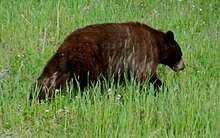
_Ursus_americanus_californiensis_skull.png)